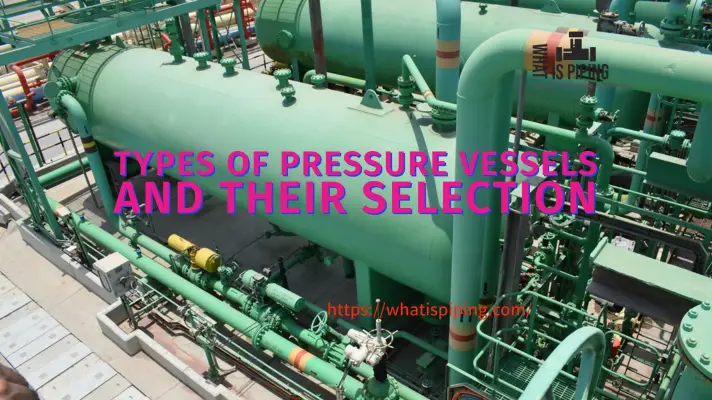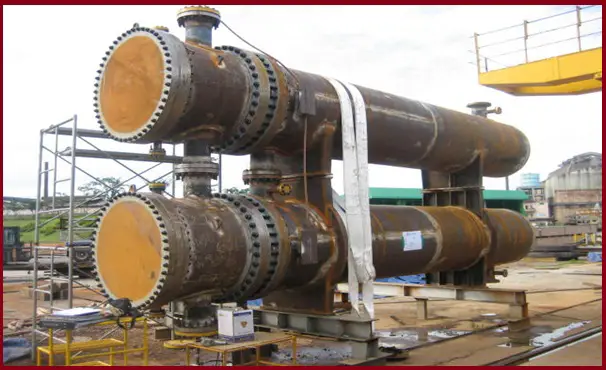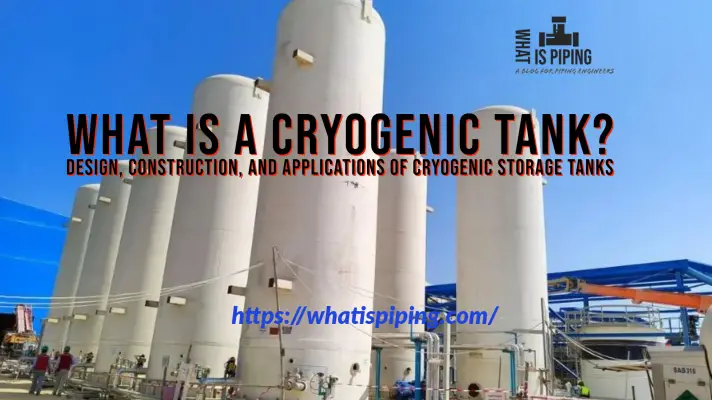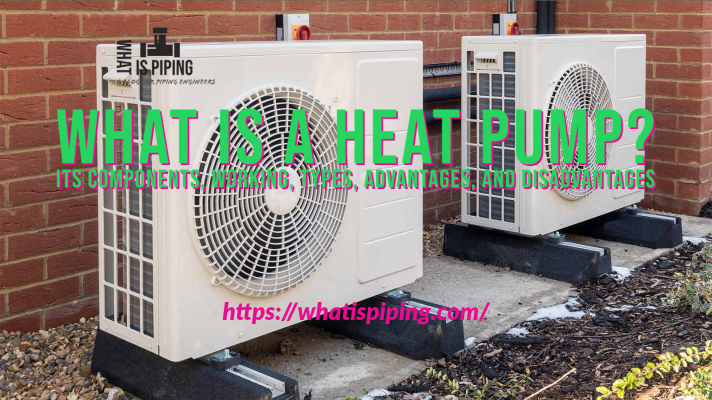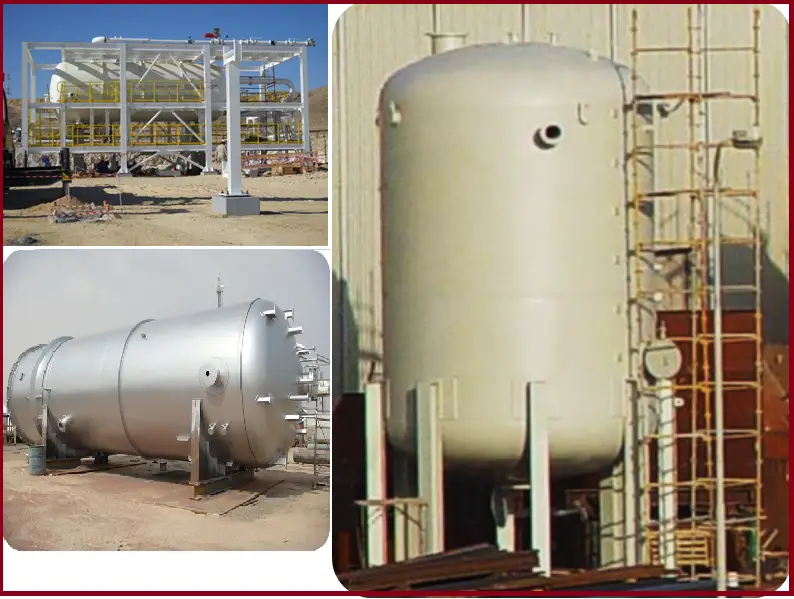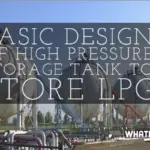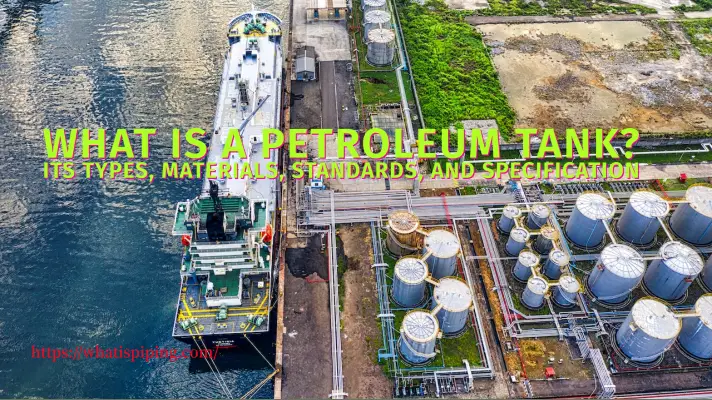Pressure vessels and storage tanks are both types of containers that are used to store fluids. However, they have different characteristics, functions, and applications. In this article, we will explore the major differences between pressure vessels and storage tanks.
What is a Pressure Vessel?
A pressure vessel is a mechanically designed container that holds gases, vapors, liquids, or two-phase fluids at pressures different from the ambient pressure. Usually, they are equipped with provisions for the introduction or removal of heat from the container. To avoid the risk of bursting, the pressure vessels are designed, fabricated, installed, and maintained following industry codes, standards, and procedures. Pressure vessels have various parts including shell, head, nozzle, saddles, skirts, etc.
The ASME BPVC is used for rules and guidelines for the design, construction, inspection, testing, and certification of pressure vessels. It ensures the safe operation of vessels under various pressure and temperature conditions. Pressure vessel manufacturers, operators, and regulators worldwide use the ASME BPVC code to ensure the integrity and safety of pressure vessels used in various industries.
What is a Storage Tank?
A storage tank can be defined as a container designed to store liquids or gases at atmospheric or low pressures. Storage tanks are usually made from thin-walled materials so they don’t hold as much pressure as pressure vessels. They’re often found to hold fuel for cars, which has less than 10 psi but is still high enough to create problems if not properly contained. Storage tanks consist of some of the important parts like shell, roof, bottom, nozzle, manhole, etc.
The API 650 and API 620 standards provide rules and guidelines for the design, construction, inspection, testing, and certification of storage tanks to ensure their safe operation under various pressure and temperature conditions. These standards are widely recognized and followed by manufacturers, operators, and regulators worldwide to ensure the integrity and safety of storage tanks used in various industries.
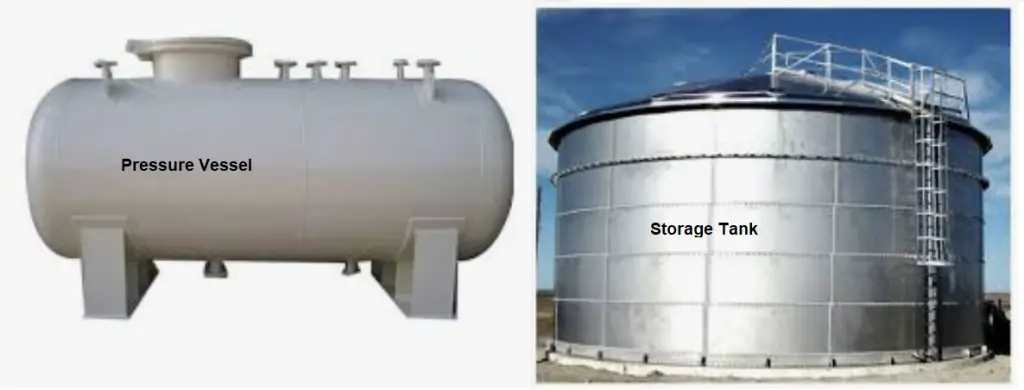
Differences between a Tank and a Pressure Vessel
Pressure vessels and storage tanks differ in several aspects, such as shape, purpose, construction, orientation, mounting, material, size, cost, and heating method. Here are some of the key differences between them:
Shape:
Pressure vessels can have various shapes, such as cylindrical, spherical, rectangular, or conical, depending on the design requirements and the type of fluid stored. Cylindrical pressure vessels are one of the most common types. They have a cylindrical shape with flat or dished ends, offering a simple and effective design for containing fluids under pressure. These vessels are used in applications such as storage tanks, air receivers, and hydraulic accumulators.
Spherical pressure vessels have a spherical shape, offering the best design for containing fluids under high pressure. These vessels are used in applications such as gas storage, liquefied natural gas (LNG) carriers, and nuclear reactors.
Rectangular pressure vessels have a rectangular shape, offering a compact design for containing fluids under low to moderate pressure. These vessels are used in applications such as water heaters, boilers, and autoclaves.
Conical pressure vessels have a conical shape, offering a tapered design for containing fluids under varying pressure. These vessels are used in applications such as rocket engines, nozzles, and diffusers.
Storage tanks, on the other hand, are usually cylindrical in shape, with flat or conical roofs and bottoms, offering a simple and economical design for storing fluids under low to moderate pressure. These tanks are used in applications such as fuel storage, water storage, and oil storage. Spherical tanks and cylindrical bullet tanks are also found for low-pressure storage applications.
Purpose:
Pressure vessels and storage tanks have different purposes, depending on the type of fluid stored and the process involved. Pressure vessels are primarily used for processing, separating, or transporting fluids under pressure. They often serve as reactors, heat exchangers, distillation towers, separators, reboilers, knock-out drums, scrubbers, dryers, coalescers, etc for various industries, including chemical, petrochemical, oil and gas, power, pharmaceutical, and food and beverage.
Storage tanks are primarily used for storing liquids or gases at a specified pressure. Storage tanks often serve as reservoirs for various industries, including petrochemicals, pharmaceuticals, and water treatment plants.
Construction:
Pressure vessels and storage tanks have different construction methods, depending on the design requirements and the type of fluid stored. Pressure vessels are usually made of thick-walled materials, such as carbon steel, stainless steel, alloy steel, or composite materials, to withstand high pressure and temperature. They are also welded, bolted, or riveted together, depending on the size and shape of the vessel. Pressure vessels are also equipped with various accessories, such as valves, gauges, safety devices, insulation, etc, to control and monitor the pressure and temperature of the fluid inside.
Storage tanks are usually made of thin-walled materials, such as carbon steel, stainless steel, aluminum, or plastic, to store low to moderate-pressure fluids. They are also fabricated, erected, or assembled on-site, depending on the size and shape of the tank. Storage tanks are also equipped with various accessories, such as vents, overflows, drains, ladders, platforms, etc, to facilitate the filling and emptying of the fluid inside.
Orientation:
Pressure vessels and storage tanks have different orientations, depending on the design requirements and the type of fluid stored. Pressure vessels can be horizontal, vertical, or inclined, depending on the space available and the flow direction of the fluid. Horizontal pressure vessels are used when the fluid has a low-density difference or a high viscosity, such as oil, water, or air. Vertical pressure vessels are used when the fluid has a high-density difference or a low viscosity, such as gas, steam, or liquid. Inclined pressure vessels are used when the fluid has a moderate density difference or a moderate viscosity, such as two-phase fluids, slurries, or mixtures.
Storage tanks are usually vertical, with flat or conical roofs and bottoms, depending on the type of fluid stored and the environmental conditions. Vertical storage tanks are used when the fluid has a low vapor pressure or a high specific gravity, such as water, oil, or diesel. Flat-roofed storage tanks are used when the fluid has a moderate vapor pressure or a moderate specific gravity, such as gasoline, kerosene, or ethanol. Conical-roofed storage tanks are used when the fluid has a high vapor pressure or low specific gravity, such as propane, butane, or ammonia.
Mounting:
Pressure vessels and storage tanks have different mounting methods, depending on the design requirements and the type of fluid stored. Pressure vessels can be supported by legs, skirts, saddles, lugs, or brackets, depending on the size, shape, and weight of the vessel. Legs are vertical supports that are attached to the bottom of the vessel, providing simple and stable support. Skirts are cylindrical or conical supports that are attached to the bottom of the vessel, providing a rigid and uniform support. Saddles are curved supports that are attached to the sides of the vessel, providing flexible and adjustable support. Lugs are protruding supports that are attached to the sides of the vessel, providing convenient and portable support. Brackets are angular supports that are attached to the sides of the vessel, providing compact and lightweight support.
Storage tanks can be supported by foundations, piers, columns, or piles, depending on the size, shape, and weight of the tank. Foundations are concrete or steel structures that are built on the ground, providing solid and durable support. Piers are vertical supports that are built on the ground, providing simple and economical support. Columns are vertical supports that are built above the ground, providing flexible and adjustable support. Piles are vertical supports that are driven into the ground, providing strong and stable support.
Size:
Pressure vessels are generally smaller in size than storage tanks, as they have to contain higher pressure and temperature. Storage tanks are larger in size than pressure vessels, as they have to store larger volumes of fluid at lower pressure and temperature.
Cost:
Pressure vessels are more expensive than storage tanks, as they require more material, labor, and quality control to ensure their safety and performance. Storage tanks are less expensive than pressure vessels, as they require less material, labor, and quality control to ensure their functionality and durability.
Below is a tabular format outlining the main differences between a pressure vessel and a storage tank:
| Pressure Vessel | Storage Tank |
|---|---|
| Pressure vessels contain gases or liquids at high pressure. | Storage tanks hold liquids or gases at atmospheric pressure or low pressure. |
| Operating under high pressure (above atmospheric pressure) is the main characteristic of every type of pressure vessel. | Storage Tanks operate at or near atmospheric pressure or low pressure. |
| Pressure vessels are engineered and designed to withstand significant internal pressure. | The design of storage tanks focuses on storing and retaining fluids with minimal pressure resistance. |
| Pressure vessels are utilized in various industries like chemical, petrochemical, power generation, mineral, food, pharmaceutical, etc. | Storage tanks are commonly used in storage applications to store fuel, water, crude oil, etc. |
| The design of pressure vessels requires rigorous stress analysis and design calculations | Storage tank generally has less complex stress analysis and design requirements |
| Pressure vessel usually has thicker walls to handle high pressure. | In most situations, storage tanks have thinner walls due to lower pressure requirements. |
| Safety relegation of pressure vessels is subjected to strict requirements and codes | The storage tank follows safety regulations but usually has fewer requirements |
| Most pressure vessels require pressure relief devices to prevent overpressure. | Storage tanks are usually equipped with vents for pressure equalization. |
| Pressure vessels can be mobile or stationary depending on the application. | Typically the storage tanks are stationary and not designed for mobility. |
Note that pressure vessels and storage tanks have distinct differences in design, purpose, and applications. However, there may be some overlap in their usage based on specific industry requirements and operating conditions.
Pressure vessels are integral components in a wide range of industries, ensuring the safe storage, transportation, and processing of fluids under pressure. Understanding the different types of pressure vessels and their specific applications is vital for engineers, designers, and professionals working with these critical components. Whether it’s cylindrical, spherical, storage, heat exchangers, or reactors, each type serves a distinct purpose and plays a significant role in various industrial processes, contributing to the advancement and safety of modern technology and infrastructure.

